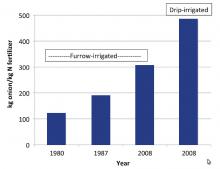
Name: Improving Nitrogen Management and Irrigation Practices Results in Efficiency and Yield
Location/Terrain: US SE Oregon and SW Idaho (Treasure Valley)
Crop(s): Onions, corn wheat, sugar beets, potatos, beans
Nutrient(s): Nitrogen and water (irrigation)
Rationale: Improve nitrogen use and increase yield output

Name: Responses of Lake Macrophyte Beds Dominated by Eurasian Watermilfoil (Myriophyllum Spicatum) to Best Management Practices (BMPs) in Agricultural Sub-Watersheds: Declines in Biomass but not Species Dominance
Location/Terrain: Conesus Lake, NY, USA
Crop(s): Livestock, row crops and others
Nutrient(s): Nitrogen and phosphorus
Rationale: To determine if agricultural BMPs could decrease Eurasian watermilfoil dominance

Name: Management of Agricultural Practices Results in Declines of Filamentous Algae in the Lake Littoral
Location/Terrain: Conesus Lake, NY, USA
Crop(s): Soybeans, livestock and cover crops
Nutrient(s): Nitrogen and phosphorus
Rationale: Decrease algae in lake littoral

Name: Site-specific Soil Management for Improved Water Use Efficiency
Location/Terrain: Santa Rosa, La Pampa, Argentina
Crop(s): Cover Crops
Nutrient(s): Water Usage, Conservation Tillage/Erosion Control
Rationale: Improve crop water use efficiency through site-specific management

Name: Payment for Ecosystems Service: Finding Long-term Market-based Solutions for Malawi’s Hydro-Electric Challenges
Location/Terrain: Upper and Middle Shire Basin, Malawi
Crop(s): Variety of unsustainable land use practices to produce predominantly maize, with limited cassava, pigeon pea and vegetable crops.
Nutrient(s): Sediment buildup from soil erosion and runoff
Rationale: Sediment buildup increases nutrients loads that speed the growth of invasive weeds and increases the operational risks of Malawi’s vital Nkula hydroelectric plant.

Name: Gulf of Mexico Project
Location/Terrain: Mississippi River Basin
Crop(s): Various crops grown along the Mississippi River
Nutrient(s): Nutrient overload from agricultural run off
Rationale: The aim of this project is to reduce the hypoxic zone in the Gulf of Mexico by addressing nutrient run off from agriculture intensive regions along the Mississippi